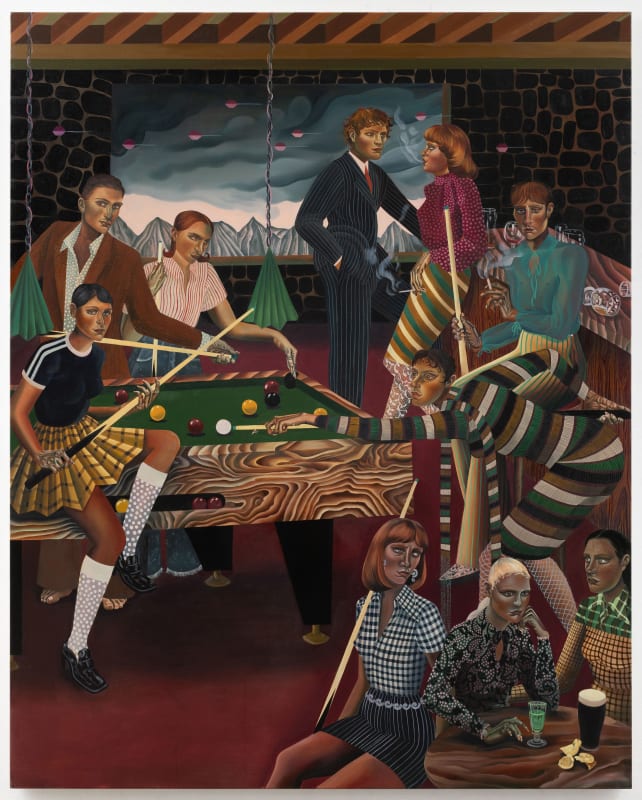Brigitte Mulholland is thrilled to present new paintings by Jessie Makinson. The seven new works mark a departure from the more fantastical imagery of recent years, as well as new modes of painting. By swapping primed canvases for a clear primed linen, Makinson was able to darken and unify her colour palette. Art historical references, pattern, texture, and humour are still abundant, with the artist relishing in knits, pleats, blades of grass, and the fuzz of tennis balls. Set in seemingly innocuous places, it is the clothing, props and uniforms that inform the spaces and set tense scenes.
These settings are recognisable: an office, a pub, a tennis court, a picnic, a gaming salon. Their simplicity allows the weird and absurd elements a more central focus: the surreal hands, the darting eyes, the palpably charged atmosphere. The figures now appear as individuals with their own interior worlds — a contrast to the anthropomorphic figures of her previous work. Makinson’s focus on minutiae thus develops in a new way, particularly through the details on clothing. The worlds of the 1970s architects in The Architects, and the 1980s-inspired tennis players in Thérèse playing tennis are built with stripes, pleats, dazzling knitwear and suiting — creating space with repetition and rules, then disrupting them with variations. The result is a visual cacophony of texture and pattern, offering flickers of Christian Schad and Otto Dix with the tense ambiguity and direct gaze of her characters.
The fantastical sensibility of Makinson’s previous work is still present, though now more subtle and atmospheric. In these new paintings, the figures are more human (save for their exaggerated hands) but getting everything wrong – architects who can’t fold their ruler, tennis players caught in a bizarrely sexual pile, schoolgirls who are a bit too old for their uniforms and can’t seem to work out how to picnic properly. The figures are charged, awkward, busy – and yet perfectly still in their tableaux, ready to pounce.
Makinson notes the influence of Edward Burra, Paula Rego, Balthus and Stanley Spencer, often directly referencing their paintings: Thérèse dreaming by Balthus becomes Thérèse playing tennis; The Players, made on residency in Newlyn, is based on the painting The cheat with the ace of clubs by Georges de la Tour. The Picnic has a particularly personal reference: the salami being coyly sliced is a direct reference to Edward Burra’s ham in The Snack Bar, 1930, a painting in Tate Britain that girls at her school were obsessed with growing up.
In all, Makinson’s new works offer a reminder of our contemporary condition and how we interact with one another: building fantasies of the everyday, made surreal through the farce and performance of her figures. The work is on view through 8 November.
